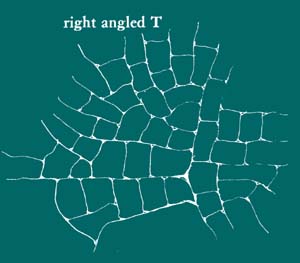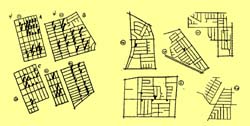
. . . if major roads are in position - PARALLEL ROADS (23), and you are in the process of defining the local roads, this pattern gives the nature of the intersections. It will also greatly influence the layout of the local roads, and will help to generate their loop like character - LOOPED LOCAL R0ADS (49).
Traffic accidents are far more frequent where two roads cross than at T junctions.
Therefore:
Lay out the road system so that any two roads which meet at grade, meet in three-way T junctions as near 90 degrees as possible. Avoid four-way intersections and crossing movements.


This follows from the geometry. Where two two-way roads cross, there are 16 major collision points, compared with three for a T junction (John Callendar, Time Saver Standards, Fourth Edition, New York, 1966, p. 1230).

Further evidence shows that the T junction is safest if it is a right-angled junction. When the angle deviates from the right angle, it is hard for drivers to see round the corner, and accidents increase (Swedish National Board of Urban Planning, "Principles for Urban Planning with Respect to Road Safety,"The Scaft Guidelines 1968, Publication No. 5, Stockholm, Sweden, p. i i).

